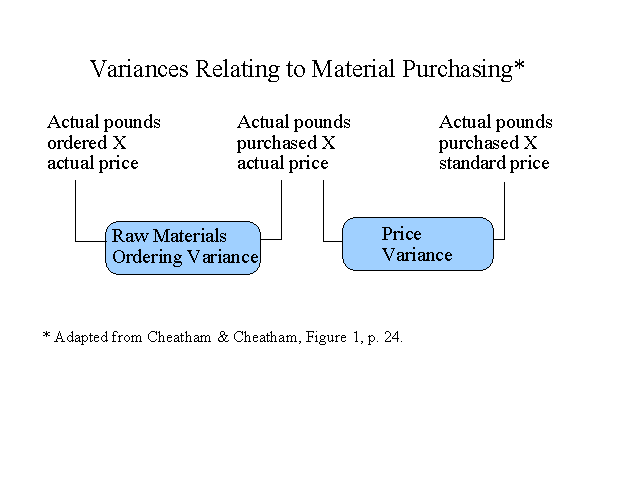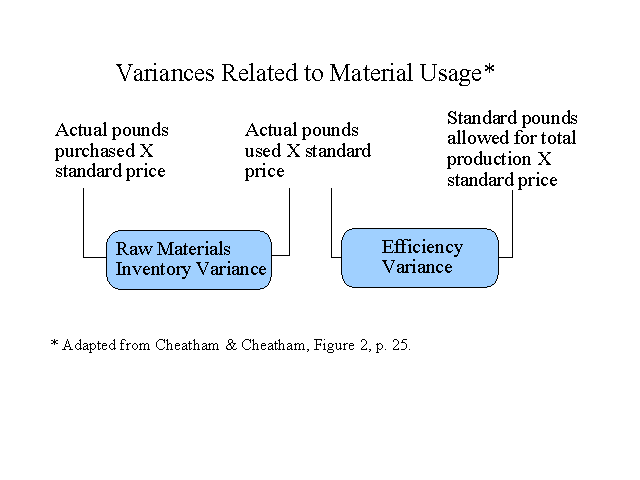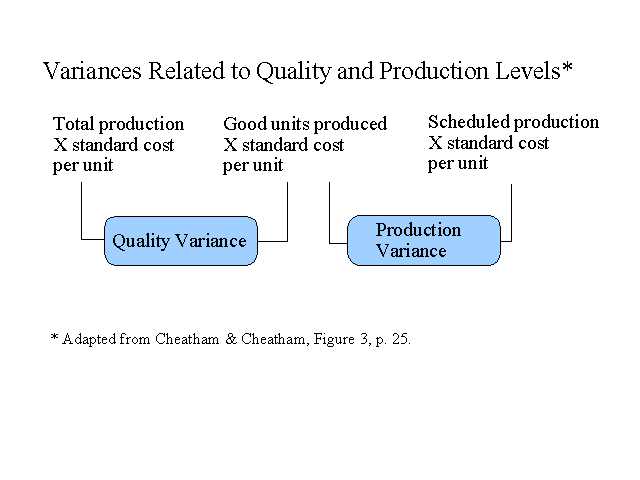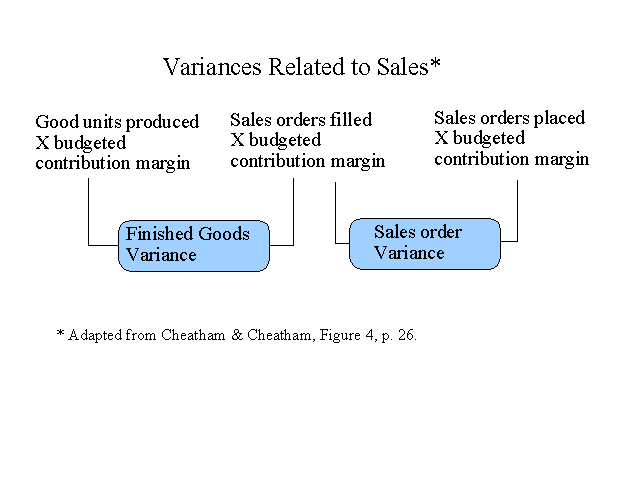
Summary by Adrienne Perez
Master of Accountancy Program
University of South Florida, Fall 2004
Continuous Improvement Main Page | Standard Costing Main Page
The purpose of this article is to provide some recommendations related to improving the usefulness of a standard costing system. The need for improvement stems from several criticisms such as the following: 1. Variances are obsolete, 2. There is no provision for continuous improvement, 3. Variances for responsibility accounting result in internal conflict instead of cooperation.
Updating the Variances in a Standard Costing System (SCS)
The criticisms are centered on the overemphasis placed on price and efficiency while excluding consideration for the quality of the materials and products manufactured. There have also been criticisms raised on the use of volume variances as a measure of utilization of capacity.This particular variance ignores any overproduction and inventory buildups. The one factor the critics fail to recognize is that variance analysis is not limited to one set of variables.The analysis can be more flexible in terms of the variables included. As a way to improve SCS, the following variances can be used.
Raw Material
The Raw Materials Ordering Variance (see illustration below) allows managers to see the effectiveness of their suppliers. A variation in the results of this variance may be considered unfavorable because the goal is to match material orders delivered with the orders placed. Raw material buildups and production delays are result from unfavorable variations. The Price Variance is the traditional variance that has been criticized as relying heavily on price.The theory is that the overemphasis on price will cause managers to compromise quality. The remedy for the above problem is to also use a quality variance to monitor material purchasing.

Material Inventories and Efficient Use
The Raw Material Inventory Variance (see below) will illustrate when inventory buildups and inventory decrease have occurred. Favorable results occur when there has been a decrease in the inventory.This idea is from the JIT philosophy. The Efficiency Variance below focuses on total production rather than good units produced as in the traditional SCS variance approach. This change was made to separate the quality component from the traditional efficiency variance.

Production Levels and Quality
The variances in this category (see graphic below) incorporate all costs in the standard cost per unit.All costs include both labor and overhead. By separating the quality factor from the traditional efficiency variance, managers can use the Quality Variance to analyze the quality of the goods manufactured.This is a critical improvement to any standard costing system.The Production Variance motivates managers to produce exactly what is needed for sales orders.A variation either way is unfavorable because inventory buildups and inability to fill sales orders are both undesirable. The Production Variance also exhibits volume differences, eliminating the need for a Volume Variance.

Sales Analysis
In the Finished Goods and Sales Order Variances, budget contribution margin is used as a measure of opportunity cost.The opportunity cost portrayed in the Finished Goods Variance is associated with orders completed but not shipped. The delay in shipment will result in a loss because there will also be a delay in payment. The Sales Order Variance’s opportunity cost is associated with sales orders that could not be filled.The results of this variance allow managers to pinpoint problems in the filling of sales orders.

Updating Standard Costing Systems for Continuous Improvement
While customizing the variances for better measurements of the different components of production, management should also consider altering their standard costing system to promote continuous improvement.Some suggestions include:
Using Prior Period’s Results as Standards,
Using Benchmarking,
Using Moving Cost Reductions - (e.g., cost improvement curves are a variation of learning curves),
Using Target Costing - (e.g., they mention the Hiromoto article).
Conclusion
According to the Cheathams, standard costing systems are not outdated, but they do need to be revised. By changing the variances to reflect the ideas discussed in this paper, and focusing on continuous improvement, standard costing systems can still be useful to managers.The authors also recommend that standard costing systems be combined with activity based costing sinceABC systems are more useful for product costing, while standard cost systems are more useful for control. The balance between the two systems provides for a more effective and efficient way to manage.
________________________________________________________
Related summaries:
Martin, J. R. Chapter 10: Standard Full Absorption Costing. Management Accounting: Concepts, Techniques & Controversial Issues.
Martin, J. R. 2000. The advantages of teaching three production volume variances. Journal of Accounting Education 18(1): 35-50. (Example of ABC variance analysis).
Primrose, P. L. 1992. Is anything really wrong with cost management? Journal of Cost Management (Spring): 48-57. (Summary).
Roehm, H. A., L. Weinstein, and J. F. Castellano. 2000. Management control systems: How SPC enhances budgeting and standard costing. Management Accounting Quarterly (Fall): 34-40. (Summary).
Stammerjohan, W. W. 2001. Better information through the marriage of ABC and traditional standard costing techniques. Management Accounting Quarterly (Fall): 15-21. (Summary).
Westra, D., M. L. Srikanth and M. Kane. 1996. Measuring operational performance in a throughput world. Management Accounting (April): 41-47. (Summary).
Wing, K. T. 2000. Using enhanced cost models in variance analysis for better control and decision making. Management Accounting Quarterly (Winter): 27-35. (Summary).